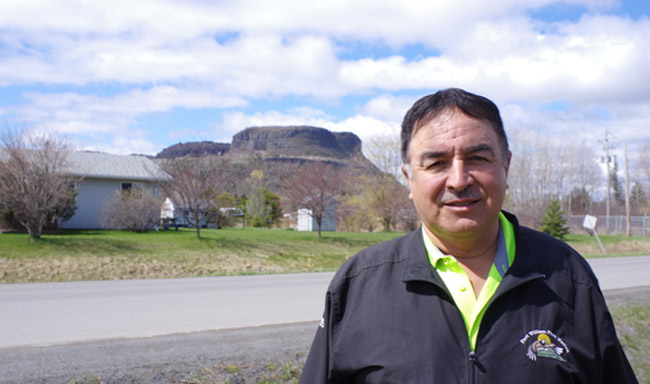Animikii-waajiw sign up in Fort William through the Ogimaa Mikana project

By Rick Garrick
The billboard sign commemorating Animikii-waajiw, Mt. McKay in Fort William, was the second billboard installed in Ontario through the Ogimaa Mikana project.
“The whole point of the project is to kind of reclaim space and reinsert Indigenous presence in place names and taking back the rights and responsibilities we have to our territories and doing it in a creative way,” says Hayden King, one of the group of people involved with the Ogimaa Mikana project. “Some of the group have connections in Thunder Bay, so we’ve been working with a few people in Fort William and Couchiching. We decided to take back Mt. McKay from the Scottish fur trader and give it back the name that Anishinabek have always called it.”
The Animikii-waajiw billboard sign was installed at the corner of Edward and Churchill in Thunder Bay until late May.
“You have to rent that space,” King says. “We only could get it for one month. When you’re driving, you can see the mountain in the background, so hopefully people put two and two together.”
The first Ogimaa Mikana billboard sign was installed in Toronto’s Parkdale neighbourhood, which was home to a relatively large Indigenous community in the 1970s and 1980s. The billboard signs are funded through an Ontario Arts Council grant, which includes funding for the installation of two more billboard signs at other locations in Ontario.
King says the Ogimaa Mikana project was initiated in the winter of 2013 by a group of people active in Indigenous politics.
“Susan Blight and I … are both language learners and we just wanted to help promote the language,” King says, noting there are about 40,000 to 60,000 Native people in Toronto but little acknowledgement of an Indigenous presence. “Toronto is actually on Indigenous territory and Toronto is an Indigenous word and Ontario is an Indigenous word and we just wanted to start making that point and reminding people that they are on Indigenous land.”
King says they also wanted to emphasize the importance of Indigenous languages to Indigenous people.
“We should be proud of our language and we should be working to bring it back and speaking it and writing it,” King says.
Fort William Chief Peter Collins says the Animikii-waajiw billboard sign highlights the traditional teachings.
“If we listen to our Elders and the teachings of our Elders, that is what they talk about: Animikii-waajiw, this great spirit of our Thunderbird,” Collins says. “There is language around our names and around our mountain and it is the sacred site of our Thunderbirds.”
Animikii-waajiw continues to be a landmark gathering place for Anishinabek and other people from across Turtle Island.
“They used to come back and use our mountain as a sacred site,” Collins says about the Indigenous people who have been visiting Animikii-waajiw since before contact. “They do healing and mentoring and they lead themselves in a healthy way of life.”
Collins says Animikii-waajiw has also been used as a Pow-Wow site since a road was built up the mountain in the 1930s.
“A re-enactment of our treaty was signed in 1932 on the mountain,” Collins says. “So the Thunderbirds looked over our community members then.”
Collins says it is important to recognize and acknowledge Indigenous place names across Turtle Island.
“Our Elder tells us that at the Union (of Ontario Indians) on a regular basis,” Collins says. “We need to get back to our culture, our language and our traditions and rebuild those cultures and traditions at the same time. This is another step in the right direction — it is important to recognize the territories and the communities where you enter and where you practice your traditional language and your traditional knowledge and teach our young people all those aspects.”


